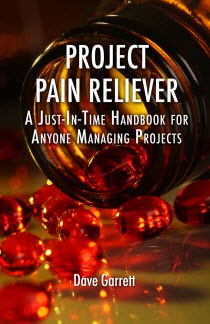How Would You Manage Frequent Changes In User Requirements?
(This post contains affiliate links. Read my full disclosure.)
This is an extract from Project Pain Reliever. I contributed two capacity.
Are your project requirements constantly changing? Are you expected to get something washed without really knowing what it is that you are supposed to be doing?
If you find yourself in a similar situation, here's what you can practice about it.
In this article:
- What should I practice?
- 1. Clear set of requirements
- 2. Set expectations
- 3. Create (or review) the alter control procedure
- You know you lot're in a good identify when…
Annotation: This article assumes you are working in a predictive environment. If you are using
However, that's not the case for people who are in a more predictive environment without the structures and culture of

What should I do?
When the requirements keep changing, it's of import to nail them down equally quickly as possible to become dorsum on track, even if you tin't see that far into the futurity. Work on what you tin manage, and put a process in place for adapting to future changes.
Plant where you are now and how you volition handle changes when something else changes – because it will!
1. Articulate prepare of requirements
Go back to your scope certificate, terms of reference, business case or project charter. What is this projection trying to attain?
This forms the underpinning structure of your requirements. List all the requirements you currently take on the project and make sure they all necktie back to the project's objectives.
Ask all your stakeholders to review the listing and confirm that information technology presents the current view of what they want the project to deliver.
If there are conflicting requirements – Marketing want the widget in blue and Customer Services want it to be orange – inquire your Sponsor to intervene. It might be easier to get everyone in the aforementioned room to agree the final list, although if you expect there will exist some conflicts yous could organize individual sessions with each of your stakeholders in the starting time example.
This exercise volition requite you a baseline for the projection'south requirements. Whatsoever changes after this demand to be assessed and taken through the change control process.
Read adjacent: How to deal with alien requirements with strategies for dealing with conflict on projects
2. Set up expectations
Set and manage expectations (here's how to do that). As part of talking to all the project's stakeholders near their requirements and the definitive listing, take the fourth dimension to explain to them that there is always a cost associated with making a change. If they modify their minds in the future and desire to add or modify a requirement, in that location will exist a price to pay. It's not always a fiscal price.
As a result of the alter:
- The project could take longer or cease earlier
- More resources could be required
- The result could exist a different quality effect to what was previously agreed
- The project could cost more.
Changes are often desirable, so they aren't something to be worried most. Embrace the changes: stakeholders should know that they do have the pick to make changes if required.
However, they should do so in the full knowledge of what the impact should be, and with guidance from you about how possible it is to make the change. For example, it is far easier to conform changes early in the project.
If you are building a hotel, it is non going to be easy to change the layout of all the bedrooms when the decorators are simply finishing upwardly. Any smaller changes that cannot be accommodated now could be packaged up into a Phase 2 or some other project in the future.
3. Create (or review) the alter control process
Now you accept a baseline of project requirements, yous need to know what to do should you be asked to brand some other change.
A modify command procedure informs how requests are handled for new requirements, or modifications to existing requirements. You may have a formal
Either way, the steps to become through are the same:
- A asking to make a change to the baselined requirements is received.
2. The change is assessed against set criteria, typically the touch on on:
- The schedule
- Resources
- Other requirements
- The upkeep
- Projection risks
- The objectives and project as a whole if the change is not done.
You may have a defined list of things confronting which to assess the change, or yous may rely on professional person judgement from the subject matter experts involved. Either is fine, but make certain the review procedure is fair and repeatable.
3. A decision is taken whether to implement the change or not.
- If yes, document the change, update the plans and schedule and permit everyone know.
- If no, tell the person who requested the change that the work volition not be done, and the reasons why.
Either selection is fine. Provide feedback as necessary to the requestor and the squad so anybody has the same expectation of what happens adjacent.
Make sure that project stakeholders and in particular, your Sponsor, empathise and agree to the modify command process that you will exist using from now on. The feel of working through this one change will help y'all talk about why it's necessary to make changes in a structured manner.
Tip: Document the decision in the change log. You could also use a decision log as a way to record any related decisions that drib out of the conversations about this change.
You know you're in a practiced place when…
You know y'all're in a good place when:
- You lot accept a clear set of requirements to act as a baseline
- Anybody understands what making changes to these ways
- Anybody understands how changes can impact the project
- You have a process in place for controlling change on the project.
Changes to requirements happen and often they are a good affair – you just have to be prepared for them when they exercise so they don't stress you out or cause stakeholders to worry when you present them with the bear upon of the alter.
If you enjoyed this affiliate, buy the volume! Project Pain Reliever, edited past Dave Garrett, is published by J. Ross and contains contributions from a broad range of projection management experts.

Pivot for later reading:
Source: https://rebelsguidetopm.com/help-the-requirements-keep-changing-and-i-cant-nail-them-down-part-2/
Posted by: birchdelitth60.blogspot.com


0 Response to "How Would You Manage Frequent Changes In User Requirements?"
Post a Comment